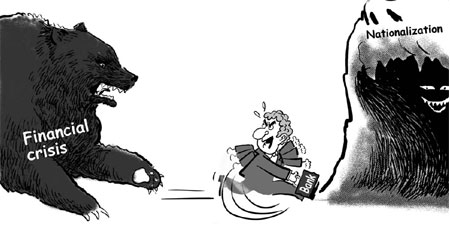
|
OPINION> Commentary
 |
|
Balancing bank and state in new model search
By Harold James (China Daily)
Updated: 2009-02-12 07:44 The most recent phase of the financial crisis, since the collapse of Lehman Brothers in September 2008, has been characterized by large bank losses and the continued threat of bank collapses. The size of the calamity raises the question of whether small countries can really afford bank bailouts. But the definition of "small" keeps changing: a few months ago, small meant Iceland, and now it means the United Kingdom. The aftermath of the banking crisis requires thinking about not only the most appropriate form of banking legislation, but also the appropriate size of the state. There has always been uncertainty about the best design of a banking system, and there has always been competition between different sorts of banking regulation. On the one hand, there is the idea - which defined banking for much of American history - that banks should be close to the risks that they must judge. This ideal grew out of Andrew Jackson's titanic struggle with Nicholas Biddle and the Second Bank of the United States. Populism was pitted against the financiers, and populism won. As a result, most nineteenth-century US banks did not have branches, and were limited to one state. The alternative approach was that of Canada, which, because of its roots in secure British rule, had much less fear of political centralization, and was prepared to tolerate a nation-wide banking system. Canada's large banking system distributed risk more widely, and fared better in episodes of financial panic, whether in 1907 or in 1929-1933.
 The larger-bank principle has two chief attractions. First, it promises more effective risk management, because large banks are less exposed to a single sort of customer (in contrast to rural American banks, which suffered when American farmers suffered). Second, it lends itself much more effectively to long-term strategic thinking about the overall direction of the national, or even the international, economy. But larger banks can get into trouble when these two principles get mixed up. The idea of the larger bank reached its high point in continental Europe, and especially in Germany, whose big banking system developed out of trade finance and into industrial finance in the late nineteenth century. By that time, countries were looking with eager interest at financial models developed elsewhere. After the 1907 panic, the US Congress convened a National Monetary Commission, whose most interesting and attractive potential model for the US was German-style universal banks, which were imitated in Russia, Japan, Italy, and Egypt. By 1931, even Britain found it hard to resist the German model. It, too, conducted an official inquiry, establishing the Macmillan Committee to hear evidence about how poorly British banks served British industry, and how the German model did a much better job at converting savings into industrial finance. The Great Depression ended this imitative surge in which the universal bank appeared to triumph. By an unfortunate coincidence, the Macmillan Committee produced its report on July 13, 1931, the day that Germany's most dynamic universal bank, the Darmstaedter Bank, failed. By the 1990s, however, emulation of other banking models was back in fashion. Financial-empire building drove late 20th century globalization. There was a competitive race across the Atlantic and - to a lesser extent - the Pacific. Indeed, gradual integration of the potentially vast European capital market, and the creation of cross-border European banks as a result of mergers, made it look as if a new European breed of superbanks was emerging. Likewise, Japan responded to its banking crisis by creating very large merged institutions, while the US repealed much of the depression-era legislation that restricted banking. Finally, after Mexico's 1994-95 peso crisis and the 1997-1998 Asian financial crisis, the US exported its new banking model to the emerging-market economies. Spanish and US banks moved heavily into Latin America. The appeal here was the opportunity for strategic vision, most clearly seen and pursued by Robert Rubin, first as Treasury Secretary in the Clinton administration and then as an adviser to the new giant of US banking, Citigroup, which emerged out of a 1998 merger. But the new superbanks were inherently vulnerable because of the vast diversity and complexity of their transactions. Long before the emergence of the sub-prime mortgage problem, Citigroup was damaged by the behavior of its London traders, who tried to manipulate the European government bond market, and by its Tokyo traders. It is much simpler for a transnational manufacturing corporation to implement controls to ensure product quality. By contrast, in a company whose business is financial intermediation, millions of judgments are made independently, and their implications may be serious enough to threaten the entire firm. When the strategy goes wrong, the recriminations begin. Traditional mid-sized European states cannot afford to have a strategic vision for their banks. But, even for the US, the notion of a world held together by Citigroup's business plan is simply too costly. There is a danger that in the push to nationalize banks as a consequence of the financial crisis, governments will see it as their duty to implement strategies. The strategic vision of a bank shaping the economic fortunes of a country, or the whole world, is as flawed as was the idea of central economic planning. Harold James is Professor of history and international affairs at the Woodrow Wilson School, Princeton University and professor of history at the European University Institute, Florence Project Syndicate (China Daily 02/12/2009 page9) |